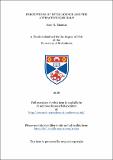Files in this item
Perceptions of intelligence and the attractiveness halo
Item metadata
| dc.contributor.advisor | Perrett, David | |
| dc.contributor.author | Talamas, Sean N. | |
| dc.coverage.spatial | xvi, 200 p. | en_US |
| dc.date.accessioned | 2017-05-25T09:50:47Z | |
| dc.date.available | 2017-05-25T09:50:47Z | |
| dc.date.issued | 2016-06 | |
| dc.identifier.uri | https://hdl.handle.net/10023/10851 | |
| dc.description.abstract | Perceptions of intelligence are strongly related to attractiveness and have a significant impact on first impressions. The introductory chapters (1 – 3) provide an overview of the literature on attractiveness, halo effects, and intelligence, while the experimental chapters (4 – 6) explore perceptions of cues to intelligence beyond attractiveness, individual differences in the susceptibility to the halo, and the accuracy of perceptions of competence. Chapter 4 investigated the malleable facial cues of eyelid-openness and mouth curvature and their influence on perceived intelligence. Attractiveness partially mediated intelligence impression, but effects of eyelid-openness and subtle smiling enhanced intelligence ratings independent of attractiveness. These effects were observed and replicated in between individual (cross-sectional) studies of natural images of adult faces, child faces, through digital manipulation of individual cues in the same faces, and in a within individual sleep-restricted sample. Chapter 5 investigated the relationship between perceived intelligence and attractiveness by exploring whether a raters’ own intelligence may be related to a stronger endorsement of the perceived intelligence-attractiveness halo. The correlation between ratings of the perceived intelligence and attractiveness was found to be stronger for participants who scored higher on an intelligence test than participants with lower intelligence test scores. Chapter 6 investigated the limiting effects of attractiveness on perceptions of competence. When statistically controlling for the attractiveness halo, academic performance could be predicted from judgments of conscientiousness but not from ratings of intelligence. Thus this thesis demonstrates that malleable facial cues can influence perceptions of intelligence independent of attractiveness, identifies an individual difference that influences endorsement of the intelligence-attractiveness halo, and shows the limiting effects of the attractiveness halo on potentially accurate perceptions of academic performance. Collectively these findings provide evidence of the powerful influence of attractiveness on perceptions of intelligence; such work is necessary if we are to mitigate such bias. | en |
| dc.language.iso | en | en_US |
| dc.publisher | University of St Andrews | |
| dc.subject.lcc | BF859.T2 | |
| dc.subject.lcsh | Face perception | en |
| dc.subject.lcsh | Interpersonal attraction | en |
| dc.subject.lcsh | Impression formation (Psychology) | en |
| dc.subject.lcsh | Intellect | en |
| dc.title | Perceptions of intelligence and the attractiveness halo | en_US |
| dc.type | Thesis | en_US |
| dc.type.qualificationlevel | Doctoral | en_US |
| dc.type.qualificationname | PhD Doctor of Philosophy | en_US |
| dc.publisher.institution | The University of St Andrews | en_US |
This item appears in the following Collection(s)
Items in the St Andrews Research Repository are protected by copyright, with all rights reserved, unless otherwise indicated.

